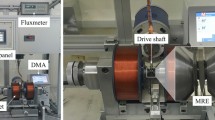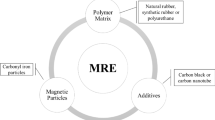Abstract
Magnetorheological Elastomers (MR Elastomers or MREs) are a kind of novel smart material, whose mechanical, electrical, magnetic properties are controllable under applied magnetic fields. They have attracted increasing attentions and broad application prospects. But conventional MREs are limited to wide applications because their MR effects and mechanical performances are not high enough. This paper aims to optimize the fabrication method and to fabricate good natural rubber based MREs with high modulus by investigating the influences of a variety of fabrication conditions on the MREs performances, such as matrix type, external magnetic flux density, and temperature, plasticizer and iron particles. Among these factors, the content of iron particles plays a most important contribution in shear modulus. When the iron particle weight fraction is 80% and the external magnetic flux density is 1 T, the field-induced increment of shear modulus reaches 3.6 MPa, and the relative MR effect is 133%. If the iron weight fraction increases to 90%, the field-induced increment of shear modulus is 4.5 MPa. This result has exceeded the best report in the literatures researching the MREs on the same kind of matrix. The dynamic performances of MREs were also experimentally characterized by using a modified Dynamic Mechanical Analyzer (DMA) system. The effects of strain amplitude and driving frequency on viscoelastic properties of MREs were analyzed.







Similar content being viewed by others
References
Carlson JD, Jolly MR (2000) Mechatronics 10:555
Rabinow J (1948) AIEE Trans 67:1308
Ginder JM (1998) MRS Bull 23(8):26
Jolly MR, Bender JW, Carlson JD (1999) J Intel Mat Syst Str 10(1):5
Bossis G, Khuzir P, Lacis S, Volkova O (2003) J Magn Magn Mater 258:456
Shiga T, Okada A, Kurauchi T (1995) J Appl Polym Sci 58:787
Jolly MR, Carlson JD, Muñoz BC, Bullions TA (1996) J Intel Mat Syst Str 7:613
Bossis G, Abbo C, Cutillas S, Lacis S, Métayer C (2001) Int J Mod Phys B 15(6 & 7):564
Bednarek S (1999) Appl Phys A 68:63
Ginder JM, Nichols ME, Elie LD, Tardiff JL (1999) In: Wuttig M (ed) Magnetorheological elastomers: properties and applications. Magnetorheological elastomers: properties and applications. Newport Beach, California, p 131
Mitsumata T, Furukawa K, Juliac E, Iwakura K, Koyama K (2002) Int J Mod Phys B 16(17 & 18):2419
Wang Y, Hu Y, Chen L, Gong X, Jiang W, Zhang P, Chen Z (2006) Polym Test 25(2):262
Lokander M, Stenberg B (2003) Polym Test 22:677
Morton M (1973) Rubber technology. Van Nostrand Reinhold, New York, p 121
Author information
Authors and Affiliations
Corresponding author
Rights and permissions
About this article
Cite this article
Chen, L., Gong, Xl., Jiang, Wq. et al. Investigation on magnetorheological elastomers based on natural rubber. J Mater Sci 42, 5483–5489 (2007). https://doi.org/10.1007/s10853-006-0975-x
Received:
Accepted:
Published:
Issue Date:
DOI: https://doi.org/10.1007/s10853-006-0975-x




